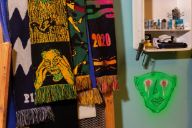The room as a clothing piece
This is just one of the many pairs of shoes that Gijs has on display . He underlines the ability of art to be a vehicle for personal expression. His character, which one can find easily communicated through his artworks, is equally reflected by his choice of clothing. Gijs shows us a plethora of different clothing styles and fashion items, from gaudy suits to baggy skate shirts. His fondness of fashion is not just visible through the clothes he wears, but his fashion pieces are just as much a part of the room collage as his other art: between the paintings and sculptures, we find a nook full of bags, shoes on display, a wall of scarfs and a stack of hats.
From the age of 13, Gijs became more and more interested in skate culture, and would dress accordingly with proper sneakers, jeans and beanies. But once he grew older and started his studies at Grafisch Lyceum Rotterdam, he began to see just how many ways there were to have an outspoken look and to portray one’s identity. From then on, he tells us, he started visiting thrift shops and exploring new fashion items. His style became much more eclectic: while still maintaining some influences from the skate scene, he took inspiration from the various subcultures he encountered during his studies. When Gijs finds a new clothing item that strikes him as particularly compelling, it will not disappear in a closet, but he will integrate it into the interior of his room.
A piece that immediately stands out, is a flashy scarf hanging from one of his cabinets. It is one of the clothing pieces that Gijs himself has designed, and this specific item was a birthday gift for a friend of his. He kept a copy of it for himself to wear as well, as the design is very dear to him. It overtly refers to the identity of The Hague: besides the jaunty green-yellow – the colors of the city’s flag as well as its soccer club ADO – the city’s proud symbol, the stork, appears on it as well. Gijs tells us this is the scarf he wears most and takes pride in wearing it.
This specific scarf shows to what extent art and clothing are connected, for Gijs at least: his own style in design interweaves with wearing what he feels most comfortable in, and expression through art and expression through clothing start to overlap. Imagine this scarf in combination with a contrasting fancy suit, and you get the sense of chaotically organized eclecticism that is reflected through the interior of Gijs’ room as well. Showing character and identity through physical appearance or interior design through an external body or an internal space might not be so different.


